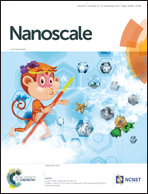Hydrogenated MoS2 QD-TiO2 heterojunction mediated efficient solar hydrogen production†
Abstract
Herein, we report the development of a hydrogenated MoS2 QD-TiO2 (HMT) heterojunction as an efficient photocatalytic system via a one-pot hydrothermal reaction followed by hydrogenation. This synthetic strategy facilitates the formation of MoS2 QDs with an enhanced band gap and a proper heterojunction between them and TiO2, which accelerates charge transfer process. Hydrogenation leads to oxygen vacancies in TiO2, enhancing the visible light absorption capacity through narrowing its band gap, and sulfur vacancies in MoS2, which enhance the active sites for hydrogen adsorption. Due to the band gap reduction of hydrogenated TiO2 and the band gap enhancement of the MoS2 QDs, the energy states are rearranged to create a reverse movement of electrons and holes facilitated the charge transfer process which enhance life-time of photo-generated charges. The photocatalyst showed stable, efficient and exceptionally high noble metal free sunlight-induced hydrogen production with a maximum rate of 3.1 mmol g−1 h−1. The developed synthetic strategy also provides flexibility towards the shape of the MoS2, e.g. QDs/single or few layers, on TiO2 and offers the opportunity to design novel visible light active photocatalysts for different applications.



 Please wait while we load your content...
Please wait while we load your content...